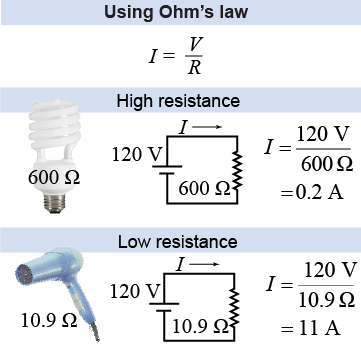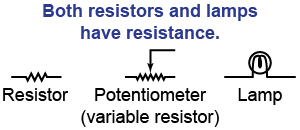|
 An ordinary light bulb has a resistance of 600 Ω. When placed in a circuit at 120 V, the light bulb draws 0.2 A and lights up as it was designed to do. A certain hairdryer has a resistance of 10.9 Ω. When connected to the same 120 V circuit, the hairdryer draws 11 A. Engineers design the resistance of electrical devices to draw the right current when connected to the right voltage. Every electrical device has a resistance and its resistance determines how much current the device draws in a circuit at the proper voltage.
An ordinary light bulb has a resistance of 600 Ω. When placed in a circuit at 120 V, the light bulb draws 0.2 A and lights up as it was designed to do. A certain hairdryer has a resistance of 10.9 Ω. When connected to the same 120 V circuit, the hairdryer draws 11 A. Engineers design the resistance of electrical devices to draw the right current when connected to the right voltage. Every electrical device has a resistance and its resistance determines how much current the device draws in a circuit at the proper voltage. 
|
 In electronic circuits resistance is created by resistors, such as the ones in the photo on the left. A resistor comes in many standard values of resistance. Resistors are used to control current, voltage, or both in electronic circuits.
In electronic circuits resistance is created by resistors, such as the ones in the photo on the left. A resistor comes in many standard values of resistance. Resistors are used to control current, voltage, or both in electronic circuits. 
|
 The symbol for any resistance in a circuit diagram is a zigzag line. The example circuits for the light bulb and hair dryer show each as a zigzag line with the resistance labeled in Ω to the side. Potentiometers are variable resistors and have a knob that is turned to change the resistance.
The symbol for any resistance in a circuit diagram is a zigzag line. The example circuits for the light bulb and hair dryer show each as a zigzag line with the resistance labeled in Ω to the side. Potentiometers are variable resistors and have a knob that is turned to change the resistance. 
|
Consider what happens when you connect the positive and negative terminals of a 1.5 V battery directly with a piece of wire, which has only a tiny resistance (such as 0.03 Ω). Ohm’s law says that the current should be extremely large—50 A in this case! Such a high current is more than enough current to melt the wire and more than the battery can deliver. That is why short circuits are dangerous! A short circuit presents a low-resistance path for current to flow, allowing too much current. Batteries can safely deliver currents up to 2 or 3 A, and the thin wires in a typical circuit used in the laboratory are chosen to handle this amount of current safely. 
 |
Why can the battery deliver only 2–3 A of current? Real batteries can be represented as a combination of a voltage source (1.5 V in this case) and a resistance (a few tenths of an ohm for a typical alkaline battery). As a battery ages, its internal resistance increases.
As you will learn later in this chapter, the battery's internal resistance and the external resistance from the wire form a series circuit, so the total resistance of the circuit is the sum of the two resistances—or a few tenths of an ohm. From Ohm's law, 1.5 V divided by (approximately) 0.3 Ω is 5 A, which is more than the 2–3 A safe range of current that the battery can deliver. When a typical battery is delivering this much current it can overheat dangerously! 
|
A simple circuit contains only wires, a light bulb with a resistance of 2 Ω, and a 1.5 V battery. How much current flows through the light bulb? | Asked: | electric current I | | Given: | resistance R = 2 Ω, voltage V = 1.5 V | | Relationships: | Ohm’s law for current: I = V/R | | Solution: | | |
| | Answer: | I = 0.75 A. | 
|

